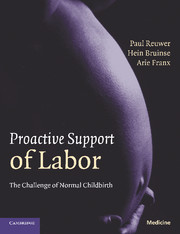Book contents
- Frontmatter
- Contents
- Foreword
- Acknowledgments
- Web-Forum
- 1 General introduction
- Section 1 A wake-up call
- Section 2 Back to basics
- Section 3 Proactive support of labor
- 12 Introductory synopsis
- 13 Nulliparous versus parous labor
- 14 Diagnosis of labor
- 15 Prevention of long labor
- 16 Personal continuity and continuous support
- 17 Amniotomy and oxytocin
- 18 Labor pain in broader perspective
- 19 Prelabor preparation
- 20 Medical pain relief revisited
- 21 Dynamic dystocia unraveled
- 22 Mechanical birth obstruction
- 23 Curtailed use of induction
- 24 Intrapartum care of the fetus
- 25 Prevention of litigation
- 26 Organizational reforms
- 27 Continual audit and feedback
- 28 Quality assessment
- 29 Hospital statistics
- 30 Sum of the parts
- Index
- References
18 - Labor pain in broader perspective
Published online by Cambridge University Press: 08 September 2009
- Frontmatter
- Contents
- Foreword
- Acknowledgments
- Web-Forum
- 1 General introduction
- Section 1 A wake-up call
- Section 2 Back to basics
- Section 3 Proactive support of labor
- 12 Introductory synopsis
- 13 Nulliparous versus parous labor
- 14 Diagnosis of labor
- 15 Prevention of long labor
- 16 Personal continuity and continuous support
- 17 Amniotomy and oxytocin
- 18 Labor pain in broader perspective
- 19 Prelabor preparation
- 20 Medical pain relief revisited
- 21 Dynamic dystocia unraveled
- 22 Mechanical birth obstruction
- 23 Curtailed use of induction
- 24 Intrapartum care of the fetus
- 25 Prevention of litigation
- 26 Organizational reforms
- 27 Continual audit and feedback
- 28 Quality assessment
- 29 Hospital statistics
- 30 Sum of the parts
- Index
- References
Summary
A significant feature of customary birth care is the emphasis placed on the physical element of labor pain and its relief. “Many maternity units seem to operate from the belief that the most important contribution caregivers can make to the comfort of women in labor is to ensure that their pain is relieved by epidural analgesia or opioid drugs.” In effect, only a minority of women in western countries currently give birth without pain medication; in the USA fewer than 17%. The overall results, however, are far from impressive, even in the short-term sense of immediate consumer satisfaction.
The nature of labor pain
Giving birth is the only physiological process in nature that causes pain, and the reasons for this have been “explained” with philosophical and religious arguments. Even so, the biological functions of pain in childbirth are clear: pain provides the warning sign to search for a safe birth environment, and endorphins promote effective and mutual mother–child bonding (Chapter 7).
Most women instinctively feel that pain in childbirth is part of life and are justifiably proud of their achievement. Being a link in procreation since Genesis, women know that they are responsible for the continued existence of the human species. Moreover, birth increases their pain threshold for the rest of their lives to an unequalled level; if men had to bear birth pain humankind would have become extinct long ago.
- Type
- Chapter
- Information
- Proactive Support of LaborThe Challenge of Normal Childbirth, pp. 150 - 156Publisher: Cambridge University PressPrint publication year: 2009



